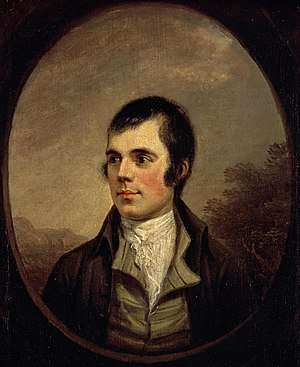Anne Rankine
Anne Rankine was the youngest daughter of a tenant farmer, John Rankine from Adamhill Farm that lay two miles from the Robert Burns's family farm at Lochlea.[1] She married John Merry, an inn-keeper in Cumnock on 29 December 1782,[2] and is buried in Cumnock old churchyard.[3] She maintained she was the 'Annie' of Robert Burns' song 'The Rigs o' Barley', however some maintain that she was merely trying to encourage business at their inn at Cumnock.[4] Her father was brother-in-law to John Lapraik the poet.[5]
Anne Rankine | |
|---|---|
| Born | circa 1759 Scotland |
| Died | 1843 New Cumnock, Scotland |
| Occupation | Housewife and Inn-keeper |
Life and character
As stated, Anne was the daughter of a tenant farmer, a friend of Robert Burns, who is described by him as "rough, rude, ready-witted Rankine".[6] She married an inn-keeper, John Merry, who died in 1802 and thereafter she ran the inn herself until she died in 1843, aged 84.[1][6] Burns lodged at the inn in August 1786, four years after the song was written.[7]
Association with Robert Burns

She maintained she was the Annie of 'The Rigs o' Barley' although she married in the same year that the song was written.[7] She was sometimes escorted by Burns to her father's house, from festive gatherings in the neighbourhood.[8] The poet was said to have been passionately fond of her and indeed he made her a gift of a lock of his hair and one of the miniature paintings of himself which she treasured all of her life, together with the song.[1] Burns himself is silent on the matter of the identity of the heroine.
The poet wrote "The Rigs o' Barley" quite early in his career with the chorus:
|
The song starts :
|
The song ends with:
|
It is said that Anne met the poet soon after the song was published in 1782 and said to him that she had not expected to be celebrated in print, to which he replied "Oh ay, I was just wanting to give you a cast among the lave!"[1]
In 1817 she was asked if she remembered nights with Burns among the rigs o' barley and she said "No!", adding however that "I mind o' many a happy night wi' him, though."[2]
Micro-history
The rigs referred to in the song were the traditional drainage system which was based on dividing fields into ridges around three feet high, and then ploughing then from end to end, the resulting furrows then drained excess water from the land above it, here planted with corn.
See also
References
- Notes
- Hill, Page 30
- Mackay, Page 72
- Burns Encyclopedia Retrieved : 2012-10-15
- Burns, R.; McGuirk, C. (1993). Selected Poems. Penguin Books Limited. ISBN 9780140423822. Retrieved 2016-12-29.
- Purdie, Page 19
- Boyle, Page 1
- Traditional Scots Songs Retrieved : 2012-10-15
- "Rankine family research". rankine-scott.me.uk. Archived from the original on 2011-11-01. Retrieved 2016-12-29.
- Sources
- Boyle, A.M. (1996). The Ayrshire Book of Burns-Lore. Darvel : Alloway Publishing. ISBN 0-907526-71-3.
- Hill, John C. Rev. (1961). The Love Songs and Heroines of Robert Burns. London : J. M. Dent.
- Mackay, James (2004). A Biography of Robert Burns. Edinburgh : Mainstream Publishing. ISBN 1-85158-462-5.
- Purdie, David; McCue Kirsteen and Carruthers, Gerrard. (2013). Maurice Lindsay's The Burns Encyclopaedia. London : Robert Hale. ISBN 978-0-7090-9194-3.